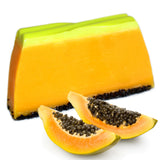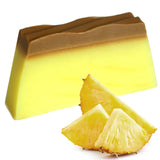















Island Oasis - Tropical Paradise Soap 100g
Our Tropical Paradise Soaps are not only a sensory delight, but they are also made with nourishing ingredients that will leave your skin feeling silky smooth and hydrated. Each soap is carefully hand-made with attention to detail, ensuring that you receive a unique and high-quality product.
With eight tantalizing variants to choose from, including Watermelon, Dragon fruit, Papaya, Pomelo, Mangosteen, Kiwifruit, Strawberry, and Pineapple, you can choose your favorite or try them all! The sweet and fruity fragrances are sure to transport you to a sunny island, making your daily shower routine feel like a blissful escape.
Our soap slices are wrapped in waxed paper, making them the perfect gift for friends and family or a luxurious treat for yourself. Each slice weighs approximately 100g, which is the perfect size for daily use.
Experience the tropical paradise of your dreams with our range of Tropical Paradise Soaps today. Please note that as our soaps are hand-made, the color or design may vary slightly from the pictures shown, adding to their unique charm!
Using tropical soap is a simple and refreshing way to cleanse your skin while enjoying a pleasant, tropical scent. Here are the general directions for using tropical soap:
1. Gather Your Supplies:
- Tropical soap bar
- Water
- A washcloth or loofah (optional)
2. Wet Your Skin:
- Start by thoroughly wetting your hands and the area of your body where you plan to use the soap. Warm water is typically more comfortable and effective for lathering soap.
3. Wet the Soap:
- Hold the tropical soap bar under running water for a few seconds to wet it. This helps create a lather more easily.
4. Lather the Soap:
- Rub the wet soap bar between your hands or onto a washcloth or loofah to create a rich, foamy lather.
5. Apply to Skin:
- Gently apply the lathered soap to your wet skin. You can use your hands, a washcloth, or a loofah to apply the soap, depending on your preference.
6. Wash and Cleanse:
- Using your hands, washcloth, or loofah, gently massage the soap onto your skin in a circular motion. Be thorough but gentle, especially if you have sensitive skin. Pay attention to areas that need extra cleansing, such as underarms, feet, and hands.
7. Rinse Thoroughly:
- Rinse your skin thoroughly with warm water to remove all the soap and any dirt or impurities. Make sure there is no soap residue left on your skin.
8. Pat Dry:
- After rinsing, pat your skin dry with a clean, dry towel. Avoid rubbing your skin vigorously, as this can irritate it.
9. Follow with Moisturizer (Optional):
- If your skin tends to be dry, you can apply a moisturizer after washing to help keep it hydrated.
10. Store the Soap: - After use, allow the tropical soap to air dry. It's a good practice to store it in a soap dish or container that allows excess water to drain away, keeping the soap dry between uses.
11. Enjoy the Tropical Scent: - One of the pleasures of using tropical soap is the delightful scent. Breathe in and enjoy the tropical aroma as you wash.
Body soap is a common and essential personal care product. While it may seem straightforward, there are some interesting and fun facts about body soap:
-
Ancient Origins: Soap-making dates back to ancient civilizations such as the Babylonians, Egyptians, and Romans. These early soaps were often made from a combination of animal fats and ash.
-
Soap Chemistry: Soap is typically made through a chemical reaction called saponification. It involves mixing fats or oils with an alkali (such as lye or sodium hydroxide) to produce soap and glycerin.
-
Types of Soap: There are various types of body soap, including bar soap, liquid soap, and specialty soaps like glycerin soap, Castile soap, and goat milk soap. Each type has its unique characteristics.
-
pH Balance: Good quality body soaps are formulated to be slightly acidic, matching the skin's natural pH level. This helps maintain the skin's moisture barrier and prevents it from becoming too dry or too oily.
-
Fragrances: Body soaps come in a wide range of fragrances, from traditional scents like lavender and rose to more unique options like tropical fruits, coffee, or even bacon-scented soap.
-
Exfoliating Varieties: Some body soaps contain exfoliating ingredients like oatmeal, coffee grounds, or fruit seeds to help slough off dead skin cells and leave the skin smoother.
-
Natural and Organic Options: With the rise in popularity of natural and organic products, many body soaps are now made from natural ingredients, free from synthetic additives and fragrances.
-
Antibacterial Claims: Some body soaps are marketed as antibacterial, although experts recommend regular handwashing with soap and water as one of the most effective ways to prevent the spread of infections.
-
Artisanal Soaps: Artisanal soapmakers craft handmade soaps in small batches. These soaps often feature unique designs, colors, and natural ingredients, making them both functional and artistic.
-
Soap Sculptures: Artists around the world have used soap as a medium for sculpting intricate and delicate works of art. Ivory soap, known for its buoyancy, is a popular choice for soap carving.
-
Soap Bubbles: Soap bubbles are not only fun but also have fascinating physics. They form when the soap molecules lower the surface tension of water, allowing air to become trapped within the thin soap film.
-
Soap Operas: The term "soap opera" originated from radio dramas that were sponsored by soap companies in the early 20th century. These dramas were often aimed at homemakers and featured advertising for soap products.
-
Biodegradability: Most traditional soap is biodegradable and environmentally friendly. It breaks down naturally in water without harming ecosystems.
-
Soap Museum: There are museums dedicated to soap around the world. For example, the Soap and Detergent Association Museum in the United States showcases the history and science of soap.
-
Soap in Space: Astronauts use specially formulated body soap in space missions. Because of the absence of gravity, traditional soap and water are not practical, so rinseless body washes are used.
Body soap is a fascinating and versatile product that has a rich history and continues to evolve with changing consumer preferences and advancements in skincare science.
